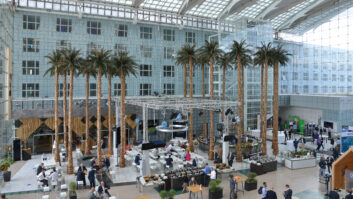
If the word “impressions” and the phrase “opportunities to see” (OTS) mean anything to you, the chances are you’ve been involved in advertising at some time in the dim and distant past. You probably recall also how print advertisements regularly featured a response coupon with a code that identified the publication from which the response came. If you engineered direct mail campaigns, you probably tried different variations of the mailer in order to determine which had the most success.
What you were trying to ascertain was what worked best in terms of content, medium and demographic – so you could do more of the same. Fast forward a number of years, and the challenges of identifying the right message in the right place at the right time to the right audience are no less difficult than they once were – and they’re at the heart of the latest developments in digital signage.
Dynamic content
It’s perhaps no surprise, then, that Stephanie Gutnik, who is vice president, business development at Broadsign, believes that the most compelling new technology to have emerged over the past 12 months is dynamic content.
“Although the technology behind this capability is not new, the use of dynamic content in the retail space has noticeably increased over the past year,” she explains. “When retailers enable their screens to automatically present content tailored to hyperlocal conditions such as weather or a viewer’s demographics, shoppers are exposed to relevant information that has a higher likelihood of driving a sale at point of purchase.”
Gutnik alludes to tailoring content – and that’s certainly an area in which digital signage is making significant strides.
“Proximity-based content is on the increase,” believes Jeff Hastings, CEO of BrightSign. “Bluetooth and beacon technology are enabling a new level of audience participation. Customers are being presented with options to interact with and control the signage from their mobile device. Audience-based content is increasingly providing a tailored experience unique to the viewer, and these technologies will allow retailers to increase sales with engaging and targeted point-of-purchase promotions.”
“Audience recognition using cameras is emerging in retail as a method to target specific content to specific types of customers,” he adds, “but the technology is still young, and users should be aware that the metrics and analytics provided may only be ‘in the ballpark’ at times.”
The Internet of Things
Increasingly, there is discussion about how digital signage is operating within the context of the Internet of Things – and there is certainly at least one key similarity.
“There are more and more installations that include sensor technology,” notes Thomas Walter, section manager, strategic product marketing at NEC Display Solutions Europe. “Sensors ensure that more relevant information is presented to the audience, creating greater engagement and trust. They can react to many triggers such as distance and touch as well as QR codes and barcodes and even rain, and provide creative and context-aware communication.”
And sometimes, it’s the simpler things that are effective.“Shelf edge displays have a surprisingly high call-to-action rate, which is why many convenience retailers are currently trialling them in store,” says Mark Childerhouse, sales director at AV integrator Pioneer Group. “Catching the consumer’s eye at that exact point of purchase is an incredibly powerful tool. We are also combining this with shelf edge pricing technologies like Tronitag which enables retailers to dynamically update product pricing across stores in line with online sales strategies.”
“Facial recognition has been demonstrated to work brilliantly to personalise an experience,” he continues. “Recently, this was deployed by a charity whose LED display in its foyer can recognise the faces of its major donors and welcome them to their HQ. This kind of specialist service is where the technology can come into its own to deliver a fantastic experience.”
Combining technologies
“The secret is not in just one technology,” summarises Yoeri Gabriel, marketing director EMEA at RMG Networks, “but in the combination of technologies and how they come together to create an overall intelligent and effective system and flow. For example, facial recognition is a very powerful tool, but when we add near-field communication (NFC) and radio frequency identification (RFID) technology to the equation we are suddenly potentially able to track and accompany the content strategy and messaging to that person or a group of people in mass targeting.”
“The secret,” he goes on, “is in how to combine a range of technologies to create a bigger, more intelligent and more effective overall digital DOOH ecosystem going forward. If utilised well, DOOH will become totally integrated within consumers’ lives in a seamless way and become a primary vehicle for brands to get targeted, or more contextually relevant, messages and content across to their intended audiences. What’s even better, gathered data, circumstantial information such as weather conditions, metrics and AI learning will guide these actions in such a smart way, that return on investment will be ever increasing.”
He has an ally in Hastings. “I’m more excited about the experience that a combination of technologies can deliver than a single technology in isolation,” he smiles. “Vegas EXP, the latest endeavour of long-time Las Vegas retail operator M&K Enterprises, perfectly illustrates the kind digitally enhanced experiential shopping that is now within reach. With a single interactive touchscreen, customers can check the weather, shop for products, browse Instagram and even socialise their experiences by taking selfies from within the store. Putting customers in the driver’s seat enables them to dictate their unique digital experiences, and that connects Vegas EXP with its customers in a very natural way that increases dwell time and ultimately sales.”







